Portland police documented 150 shootings last month, the most in a single month since the police bureau started collecting gun violence data at the end of 2018.
The new high comes after more than a year of steadily increasing gun violence, both in Portland and nationwide, that has left policymakers scrambling for a solution to a problem that isn’t well understood.
Gun violence started to rise at the end of 2019 and the numbers have only become more bleak.
The 49 people injured in Portland shootings last month exceeded the previous high of 38 set the month before. Month-over-month homicides decreased slightly in July, but the city is already only five short of last year’s 57 total homicides. At 717 shootings so far this year, the city also is on track to easily surpass last year’s total of 891 shootings.
One particularly grisly shooting in the early hours of July 17 saw six people injured in downtown Portland. Makayla Maree Harris, 18, was killed in that shooting.

Makayla Maree Harris, 18, was shot and killed in downtown Portland July 17, 2021. The shooting was one of 150 in July that left 49 people injured and 5 dead.
Portland Police Bureau
While national violent crime rates have plummeted since the early ‘90s and remain near historically low levels, Portland leaders have still struggled to respond to the recent upswing.
In February, the police bureau created an “enhanced community safety team,” a group of sergeants, officers and detectives who respond to shootings, collect evidence, and conduct investigations.
The following month, shootings still rose 24% and have shown no sign of abating.
Less than two months after the gun violence team was created, on April 7, the mayor and City Council cleared the path for the bureau to create a focused intervention team, a team of two sergeants and 12 officers who would work with a newly formed community oversight group and data analyst to interrupt cycles of retaliatory violence and get guns off the streets.
“To staff this team, we will select, on-board, and deploy 12 Officers and 2 Sergeants in a manner consistent with our commitment to community involvement in these processes,” an April 6 memo to mayoral aide Sam Adams from Deputy Chief Chris Davis said. “This process should take approximately 30 to 45 days, given the need to identify the community stakeholders with whom we will work, as well as City processes for selections for special assignments.”
On May 19, the day after a North Portland shooting drew large crowds to the Legacy Emanuel emergency department where survivors had been brought, Portland Mayor Ted Wheeler sent an exasperated text message to Police Chief Chuck Lovell.
“Chief, I am authorizing you to deploy the focused intervention team without the community oversight panel,” Wheeler texted. “Do so ASAP. I am prepared to take the political heat internally including resignation. Deploy the team.”

Portland Mayor Ted Wheeler speaks at a press conference in Portland, Ore., Friday, March 20, 2020.
Bradley W. Parks / OPB
The police bureau posted internal job postings for the team the following day, according to Tim Becker, Wheeler’s spokesperson.
“The PPB began the process immediately after the Mayor authorized it, and continues to field applications from candidates to fill the positions,” Becker told OPB.
But more than two months after the police bureau began recruiting internally for the new focused intervention team, there is little enthusiasm for the assignment.
“There weren’t enough applicants to field the team,” Portland Police Bureau spokesperson Lt. Greg Pashley said. “And so the police bureau is trying to identify the supervisory team which is really a more natural way to create a unit like this from scratch.”
He said officers want to know who they are going to be working for which may have prevented many officers from applying. Another possible obstacle, Pashley said, low morale inside the bureau might make officers reluctant to take on a new job after watching the now-disbanded Gun Violence Reduction Team face community backlash.
Pashley said violence interruption is a specialized skill, and assigning people to the sensitive work is not an ideal approach to filling the new team. The officers who formed the Gun Violence Reduction Team had those skills, but Pashley said many are no longer available for the work because they’ve been promoted, taken other assignments, or have left the bureau.
Recruitment for the team is now focused on finding leaders first.
“Sergeants have the ability to make phone calls to people that they know, who might have the gifts and talents for this kind of specialized assignment, and start talking to them about ... how they might fit as a member of the team,” Pashley said.
Even if the bureau staffs and fields the new team, law enforcement programs to interrupt cycles of violence and prevent shootings have a spotty track record. Positive impacts often taper off or reversed after the first year or two. Shootings and homicides have remained constant or have increased in the years the Gun Violence Reduction Team was operating.
There is no consensus among experts as to what is causing the local or national uptick in shootings and homicides. Economic uncertainty, social unrest, and a record setting surge in gun purchases last year might play a role. The pandemic also took young people out of school, and many of the community organizations that work with people most impacted by gun violence shut down or went virtual. But as people have returned to work, protests have ebbed, and research has questioned the role new gun purchases are playing, one constant about crime rates has remained unchanged: They’re not very well understood.

Portland police investigate the scene at a Motel 6 where earlier an officer shot and killed a man on June 24, 2021 in Portland, Oregon.
Jonathan Levinson / OPB
Portland State University criminology professor Brian Renauer said high concentrations of people living below the poverty line, high rates of unemployment and other socioeconomic indicators often correlate to higher rates of neighborhood violence. And because the impacts of those factors may not manifest for years, Renauer said it’s possible we’re only just now seeing the impact of the 2008 recession.
“Maybe we’re actually feeling the ramifications of the struggling economy in the early 2010s that impacted families, impacted the youth growing up in those families,” Renauer told OPB in December. “And now, we’re seeing the repercussions of it as those youth are now in their teenage and young adult years.”
Statewide, another gun violence record is in danger of being toppled this year. There have been at least 23 police shootings so far this year, putting law enforcement in the state on track to break the previous record set in 2018, when police shot 37 people.
